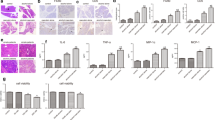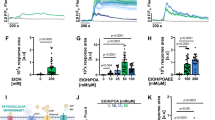Abstract
Alcoholic chronic pancreatitis (ACP) is a serious inflammatory disease causing significant morbidity and mortality. Due to lack of a suitable animal model, the underlying mechanism of ACP is poorly understood. Chronic alcohol abuse inhibits alcohol dehydrogenase (ADH) and facilitates nonoxidative metabolism of ethanol to fatty acid ethyl esters (FAEEs) in the pancreas frequently damaged during chronic ethanol abuse. Earlier, we reported a concentration-dependent formation of FAEEs and cytotoxicity in ethanol-treated rat pancreatic tumor (AR42J) cells, which express high FAEE synthase activity as compared to ADH and cytochrome P450 2E1. Therefore, the present study was undertaken to investigate the role of various ethanol oxidizing enzymes in ethanol-induced pancreatic acinar cell injury. Confluent AR42J cells were pre-treated with inhibitors of ADH class I and II [4-methylpyrazole (MP)] or class I, II, and III [1,10-phenanthroline (PT)], cytochrome P450 2E1 (trans-1,2-dichloroethylene) or catalase (sodium azide) followed by incubation with 800 mg% ethanol at 37°C for 6 h. Ethanol metabolism, cell viability, cytotoxicity (apoptosis and necrosis), cell proliferation status, and formation of FAEEs in AR42J cells were measured. The cell viability and cell proliferation rate were significantly reduced in cells pretreated with 1,10-PT + ethanol followed by those with 4-MP + ethanol. In situ formation of FAEEs was twofold greater in cells incubated with 1,10-PT + ethanol and ∼1.5-fold in those treated with 4-MP + ethanol vs. respective controls. However, cells treated with inhibitors of cytochrome P450 2E1 or catalase in combination of ethanol showed no significant changes either for FAEE formation, cell death or proliferation rate. Therefore, an impaired ADH class I–III catalyzed oxidation of ethanol appears to be a key contributing factor in ethanol-induced pancreatic injury via formation of nonoxidative metabolites of ethanol.






Similar content being viewed by others
Explore related subjects
Discover the latest articles and news from researchers in related subjects, suggested using machine learning.References
Bhat H. K.; Ansari G. A. S. Cholesterol ester hydrolase-mediated conjugation of haloethanols with fatty acids. Chem. Res. Toxicol. 3: 311–317; 1990.
Bhopale K.; Wu H.; Boor P. J.; Ansari G. A. S.; Kaphalia B. S. Metabolic basis of ethanol-induced hepatic and pancreatic toxicity in hepatic alcohol dehydrogenase deficient deer mice. Alcohol 39: 179–188; 2006.
Brunner R.; Xie J.; Bank S. Does acute alcoholic pancreatitis exist with preexisting chronic pancreatitis? J. Clin. Gastroenterol. 38: 201–202; 2004.
Christophe J. Pancreatic tumoral cell line AR42J. An amophicrine model. Am. J. Physiol. 266: G963–G971; 1994.
Chrostek L.; Jelski W.; Szmitkowski M.; Puchalski Z. Alcohol dehydrogenase (ADH) isoenzymes and aldehyde dehydrogenase (ALDH) activity in the human pancreas. Dig. Dis. Sci. 48: 1230–1233; 2003.
Criddle D. N.; Raraty M. G.; Neoptolemos J. P.; Tepikin A. V.; Petersen O. H.; Sutton R. Ethanol toxicity in pancreatic acinar cells: mediation by nonoxidative fatty acid metabolites. Proc. Natl. Acad. Sci. U. S. A. 101: 10738–10743; 2004.
Criddle D. N.; Sutton R.; Petersen O. H. Role of Ca2+ in pancreatic cell death induced by alcohol metabolites. J. Gastroenterol. Hepatol. Suppl. 3: S14–S17; 2006.
Fernando H.; Wiktorowicz J. E.; Soman K. V.; Kaphalia B. S.; Khan M. F.; Ansari G. A. S. Liver proteomics in progressive alcoholic steatosis. Toxicol. Appl. Pharmacol. 266: 470–480; 2013.
Foster J. R.; Idle J. R.; Hardwick J. P. et al. Induction of drug-metabolizing enzymes in human pancreatic cancer and chronic pancreatitis. J. Pathol. 169: 457–463; 1993.
Gukovskaya A. S.; Mouria M.; Gukovskaya I.; Reyes C. N.; Kasho V. N.; Faller L. D.; Pandol S. J. Ethanol metabolism and transcription factor activation in pancreatic acinar cells in rats. Gastroenterology 122: 106–118; 2002.
Haber P. S.; Apte M. V.; Applegate T. L.; Norton I. D.; Korsten M. A.; Pirola R. C.; Wilson J. S. Metabolism of ethanol by rat pancreatic acinar cells. J. Lab. Clin. Med. 132: 294–302; 1998.
Haber P. S.; Wilson J. S.; Apte M. V.; Pirola R. C. Fatty acid ethyl esters increases rat pancreatic lysosomal fragility. J. Lab. Clin. Med. 121: 759–764; 1993.
Kaphalia B. S. Pancreatic toxicology. In: Nriagu J. O. (ed) Encyclopedia of Environmental Health, vol. 4. Elsevier, Burlington, pp 315–324; 2011.
Kaphalia B. S.; Ansari G. A. S. Fatty acid ethyl esters and ethanol-induced pancreatic injury. Cell. Mol. Biol. 47: OL173–OL179; 2001.
Kaphalia B. S.; Ansari G. A. S. Purification and characterization of rat pancreatic fatty acid ethyl ester synthase and its structural and functional relationship to pancreatic cholesterol esterase. J. Biochem. Mol. Toxicol. 17: 338–345; 2003.
Kaphalia B. S.; Cai P.; Khan M. F.; Okorodudu A. O.; Ansari G. A. S. Fatty acid ethyl esters; markers of alcohol abuse and alcoholism. Alcohol 34: 151–158; 2004.
Kaphalia B. S.; Green S. M.; Ansari G. A. S. Fatty acid ethyl and methyl ester synthases, and fatty acid anilide synthase in HepG2 and AR42J cells: interrelationships and inhibition by tri-o-tolyl phosphate. Toxicol. Appl. Pharmacol. 159: 134–141; 1999.
Kaphalia B. S.; Khan M. F.; Carroll R. M.; Aronson J.; Ansari G. A. S. Subchronic toxicity of 2-chloroethanol and 2-bromoethanol in rats. Res. Commun. Pharmacol. Toxicol. 1: 173–186; 1996.
Kessova I. G.; DeCarli L. M.; Lieber C. S. Inducibility of cytochrome P4502E1 and P4501A1 in the rat pancreas. Alcohol. Clin. Exp. Res. 22: 501–504; 1998.
Lankisch P. G.; Banks P. A. Pancreatitis. Springer, Berlin, Heidelberg, New York, p 377; 1998.
Lange L. G.; Sobel B. E. Mitochondrial dysfunction induced by fatty acid ethyl esters, myocardial metabolites of ethanol. J. Clin. Invest. 72: 724–731; 1983.
Laposata E. A.; Lange L. G. Presence of nonoxidative ethanol metabolism in humans organs commonly damaged by ethanol abuse. Science 231: 497–499; 1986.
Manautou J. E.; Carlson G. P. Ethanol-induced fatty acid ethyl ester formation in vivo and in vitro in rat lung. Toxicology 70: 303–312; 1991.
Mathews J. M.; Etheridge A. S.; Raymer J. H.; Black S. R.; Pulliam Jr. D. W.; Bucher J. R. Selective inhibition of cytochrome P450 2E1 in vivo and in vitro with trans-1,2-dichloroethylene. Chem. Res. Toxicol. 11: 778–785; 1998.
Norton I. D.; Apte M. V.; Haber P. S.; McCaughan G. W.; Pirola R. C.; Wilson J. S. Cytochrome P4502E1 is present in rat pancreas and is induced by chronic ethanol administration. Gut 42: 426–430; 1998.
Nuutinen H.; Lindros K. O.; Salaspuro M. Determinants of blood acetaldehyde level during ethanol oxidation in chronic alcoholics. Alcohol. Clin. Exp. Res. 7: 163–168; 1983.
Panes J.; Caballeria J.; Guitart R.; Pares A.; Soler X.; Rodamilans M.; Navasa M.; Pares X.; Bosch J.; Rodes J. Determinants of ethanol and acetaldehyde metabolism in chronic alcoholics. Alcohol. Clin. Exp. Res. 17: 48–53; 1993.
Panes J.; Soler X.; Pares A.; Caballeria J.; Farres J.; Rodes J.; Pares X. Influence of liver disease on hepatic alcohol and aldehyde dehydrogenases. Gastroenterology 97: 708–714; 1989.
Pfutzer R. H.; Tadic S. D.; Li H. S.; Thompson B. S.; Zhang J. Y.; Ford M. E.; Eagon P. K.; Whitcomb D. C. Pancreatic cholesterol esterase, ES-10, and fatty acid ethyl ester synthase III gene expression are increased in the pancreas and liver but not in the brain or heart with long-term ethanol feeding in rats. Pancreas 25: 101–106; 2002.
Pitchumoni C. S.; Glasser M.; Saran R. M.; Panchacharam P.; Thelmo W. Pancreatic fibrosis in chronic alcoholics and non alcoholics without clinical pancreatitis. Am. J. Gastroenterol. 79: 382–388; 1984.
Rognstead R.; Grunnet N. Enzymatic pathways of ethanol metabolism. In: Majchrowicz E.; Noble E. P. (eds) Biochemistry and Pharmacology of Ethanol. Plenum Press, New York, pp 65–86; 1979.
Singh M.; Simsek H. Ethanol and the pancreas: current status. Gastroenterology 98: 1051–1062; 1990.
Werner J.; Laposata M.; Fernandez-del Castillo C.; Saghir M.; Iozzo R. V.; Lewandrowski K. B.; Warshaw A. L. Pancreatic injury in rats induced by fatty acid ethyl ester, a nonoxidative metabolite of alcohol. Gastroenterology 113: 286–294; 1997.
Werner J.; Saghir M.; Warshaw A. L.; Lewandrowski K. B.; Laposata M.; Iozzo R. V.; Carter E. A.; Schatz R. J.; Fernandez-Del C. C. Alcoholic pancreatitis in rats: injury from nonoxidative metabolites of ethanol. Am. J. Physiol. Gastroentest. Liver Physiol. 283: G65–G73; 2002.
Wilson J. S.; Korsten M. A.; Apte M. V.; Thomas M. C.; Haber P. S.; Pirola R. C. Both ethanol consumption and protein deficiency increase the fragility of pancreatic lysosomes. J. Lab. Clin. Med. 115: 749–755; 1990.
Wu H.; Bhopale K. K.; Ansari G. A. S.; Kaphalia B. S. Ethanol-induced cytotoxicity in rat pancreatic acinar AR42J cells: role of fatty acid ethyl esters. Alcohol Alcohol. 43: 1–8; 2008.
Wu H.; Cai P.; Clemens D. L.; Jerrells T. R.; Ansari G. A. S.; Kaphalia B. S. Metabolic basis of ethanol-induced cytotoxicity in recombinant HepG2 cells: role of nonoxidative metabolism. Toxicol. Appl. Pharmacol. 216: 238–247; 2006.
Acknowledgments
This work was supported by NIH grant AA19812 from the National Institute on Alcohol Abuse and Alcoholism. The authors also acknowledge the support of NIEHS Center grant P30ES06676 for Exposure Assessment and Biomarker Development Core for the analysis of ethanol and acetaldehyde.
Author information
Authors and Affiliations
Corresponding author
Additional information
Editor: T. Okamoto
Rights and permissions
About this article
Cite this article
Bhopale, K.K., Falzon, M., Ansari, G.A.S. et al. Alcohol oxidizing enzymes and ethanol-induced cytotoxicity in rat pancreatic acinar AR42J cells. In Vitro Cell.Dev.Biol.-Animal 50, 373–380 (2014). https://doi.org/10.1007/s11626-013-9700-7
Received:
Accepted:
Published:
Issue Date:
DOI: https://doi.org/10.1007/s11626-013-9700-7




